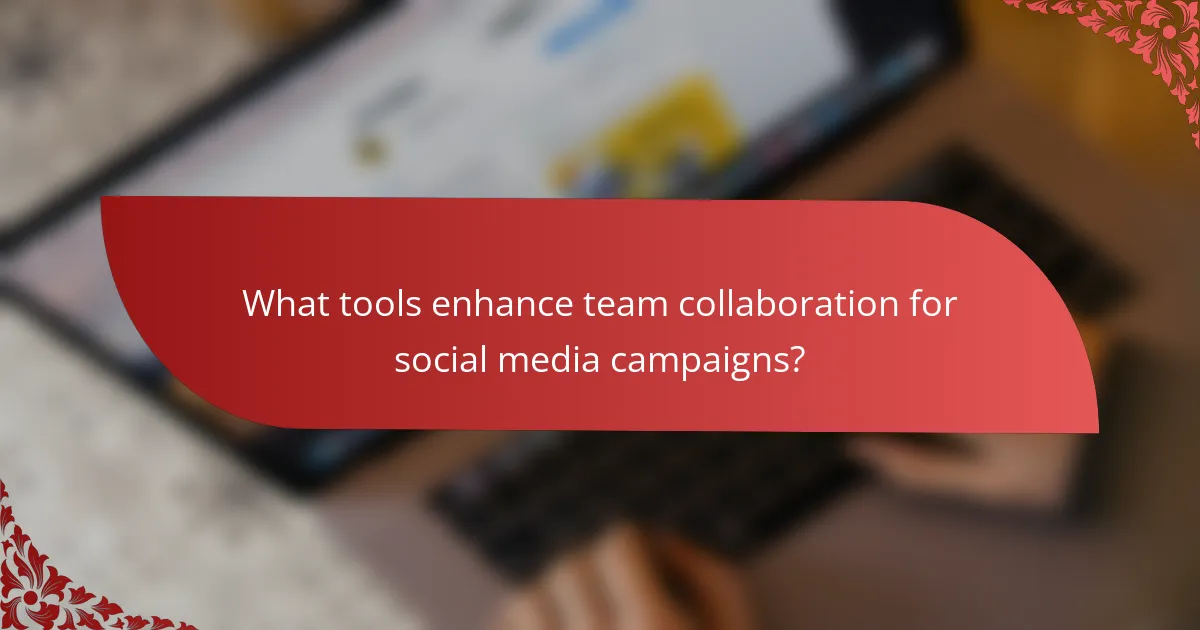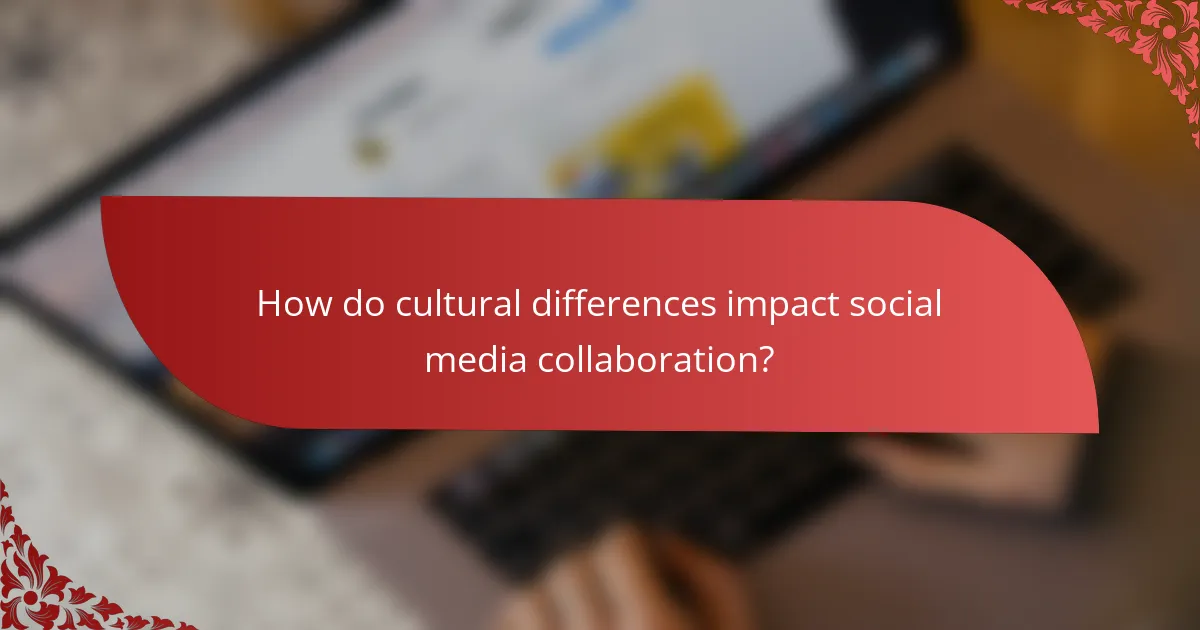Successful social media campaigns rely on effective team collaboration, which is rooted in clear communication, defined roles, and consistent updates. By implementing best practices such as audience research and data-driven decision-making, teams can enhance their strategies and achieve better engagement. Utilizing the right tools further streamlines processes, allowing for efficient project management and cohesive teamwork.

What are the best practices for team collaboration in social media campaigns?
Effective team collaboration in social media campaigns hinges on clear communication, defined roles, and regular updates. These practices ensure that all team members are aligned and can contribute effectively to the campaign’s success.
Clear communication channels
Establishing clear communication channels is crucial for team collaboration in social media campaigns. Utilize platforms like Slack or Microsoft Teams to facilitate real-time discussions and quick feedback. This reduces misunderstandings and keeps everyone informed about campaign developments.
Regularly scheduled meetings can also enhance communication. Consider daily or weekly check-ins to discuss progress and address any challenges. This ensures that all team members are on the same page and can share insights effectively.
Defined roles and responsibilities
Clearly defining roles and responsibilities helps streamline the workflow within a social media campaign. Each team member should know their specific tasks, whether it’s content creation, graphic design, or analytics. This clarity minimizes overlap and confusion, allowing for more efficient collaboration.
Creating a responsibility matrix can be beneficial. This matrix outlines who is accountable for each task, making it easier to track progress and hold team members accountable. It also helps in identifying gaps in skills or resources that may need to be addressed.
Regular check-ins and updates
Regular check-ins and updates are essential for maintaining momentum in social media campaigns. Schedule brief meetings to review progress, discuss upcoming tasks, and adjust strategies as needed. This practice fosters accountability and keeps the team engaged.
Consider using project management tools like Trello or Asana to track tasks and deadlines. These platforms allow team members to update their progress and provide visibility into the overall campaign status, making it easier to manage timelines and deliverables.
Utilizing collaboration tools
Leveraging collaboration tools can significantly enhance team efficiency in social media campaigns. Tools like Google Drive or Dropbox facilitate easy sharing of documents and assets, ensuring that everyone has access to the latest materials.
Additionally, using design tools like Canva or Adobe Spark allows team members to collaborate on visual content in real-time. This can speed up the creative process and ensure that all team members can contribute their ideas effectively.
Setting measurable goals
Setting measurable goals is vital for assessing the success of social media campaigns. Define specific, quantifiable objectives such as increasing engagement rates by a certain percentage or growing follower counts within a set timeframe. This provides a clear target for the team to strive towards.
Utilize analytics tools to track progress against these goals. Regularly review performance metrics and adjust strategies as necessary to ensure that the campaign remains on track. This data-driven approach helps in making informed decisions and optimizing future efforts.

How can teams improve their social media strategy?
Teams can enhance their social media strategy by focusing on collaboration, clear communication, and data-driven decision-making. Implementing best practices such as audience research, content planning, and analytics can lead to more effective campaigns and better engagement.
Conducting audience research
Understanding your audience is crucial for tailoring content that resonates. Conduct surveys, analyze demographics, and monitor social media interactions to gather insights about preferences and behaviors.
Utilize tools like Google Analytics or social media insights to identify key audience segments. Aim to create personas that represent your typical followers, which can guide your messaging and content style.
Creating a content calendar
A content calendar helps teams plan and organize their social media posts in advance. This ensures a consistent posting schedule and allows for better coordination among team members.
Include important dates, campaigns, and themes in your calendar. Tools like Trello or Asana can facilitate collaboration, allowing team members to assign tasks and track progress effectively.
Leveraging analytics for insights
Analytics provide valuable data on how your social media campaigns are performing. Regularly review metrics such as engagement rates, reach, and conversion rates to understand what works and what doesn’t.
Use this data to adjust your strategy, focusing on high-performing content types and posting times. Consider A/B testing different approaches to refine your tactics further and maximize impact.

What tools enhance team collaboration for social media campaigns?
Effective team collaboration for social media campaigns can be significantly improved with the right tools. These tools streamline communication, project management, scheduling, and document sharing, enabling teams to work more efficiently and cohesively.
Trello for project management
Trello is an intuitive project management tool that uses boards, lists, and cards to organize tasks. Teams can create boards for different campaigns, assign tasks to members, and track progress visually. This method helps ensure everyone is aware of their responsibilities and deadlines.
To maximize Trello’s effectiveness, establish clear labels and due dates for each task. Regularly review boards in team meetings to keep everyone aligned and address any bottlenecks promptly.
Slack for communication
Slack is a powerful communication platform that facilitates real-time messaging, file sharing, and collaboration. It allows teams to create channels for specific projects or topics, ensuring discussions remain organized and focused. This reduces email clutter and speeds up decision-making.
Encourage team members to use threads for specific conversations to keep channels tidy. Utilize integrations with other tools like Trello and Hootsuite to streamline workflows and keep all relevant information in one place.
Hootsuite for scheduling
Hootsuite is a comprehensive social media management tool that allows teams to schedule posts across multiple platforms from a single dashboard. This feature helps maintain a consistent posting schedule and frees up time for content creation and engagement.
To optimize scheduling, analyze the best times to post based on audience engagement metrics. Use Hootsuite’s analytics to track performance and adjust your strategy as needed, ensuring your content reaches its intended audience effectively.
Google Workspace for document sharing
Google Workspace provides a suite of tools for document creation, sharing, and collaboration. Google Docs, Sheets, and Slides allow team members to work simultaneously on content, making it easy to gather feedback and make revisions in real-time.
Set up shared folders for each campaign to keep documents organized and accessible. Encourage the use of comments and suggestions features to facilitate constructive feedback without altering the original content directly.

What are the key metrics for measuring campaign success?
Key metrics for measuring social media campaign success include engagement rates, conversion rates, reach, impressions, and return on investment (ROI). These metrics provide insights into how well a campaign is performing and where improvements can be made.
Engagement rates
Engagement rates measure the level of interaction users have with your content, including likes, shares, comments, and clicks. A higher engagement rate indicates that your audience finds the content relevant and appealing. Aim for engagement rates typically between 1% to 5%, depending on the platform.
To improve engagement, focus on creating high-quality, visually appealing content that resonates with your target audience. Utilize interactive elements like polls or questions to encourage participation.
Conversion rates
Conversion rates reflect the percentage of users who take a desired action, such as signing up for a newsletter or making a purchase, after engaging with your campaign. A good conversion rate generally falls between 2% to 5%, but this can vary by industry and campaign type.
To enhance conversion rates, ensure your calls-to-action (CTAs) are clear and compelling. A/B testing different CTAs can help identify which messages resonate best with your audience.
Reach and impressions
Reach refers to the total number of unique users who see your content, while impressions count the total number of times your content is displayed, regardless of whether it was clicked. High reach indicates a broad audience, while high impressions suggest repeated visibility.
To maximize reach and impressions, consider using paid promotions and targeting specific demographics. Regularly analyze which types of content generate the most visibility to refine your strategy.
Return on investment
Return on investment (ROI) measures the profitability of your campaign by comparing the revenue generated against the costs incurred. A positive ROI indicates that your campaign is financially successful, while a negative ROI suggests reevaluation is necessary.
To calculate ROI, use the formula: (Revenue – Cost) / Cost x 100. Aim for an ROI of at least 100% to ensure your campaign is worthwhile. Regularly track expenses and revenue to maintain a clear understanding of your campaign’s financial health.

What frameworks can guide social media campaign planning?
Effective social media campaign planning can be guided by frameworks like SMART goals and SWOT analysis. These tools help teams set clear objectives and assess their strengths and weaknesses, leading to more successful campaigns.
SMART goals framework
The SMART goals framework ensures that campaign objectives are Specific, Measurable, Achievable, Relevant, and Time-bound. For example, instead of stating “increase engagement,” a SMART goal would be “achieve a 20% increase in post interactions over the next three months.”
When implementing SMART goals, consider the resources available and the target audience. Setting realistic benchmarks helps maintain motivation and focus. Regularly review progress to adjust strategies as needed.
SWOT analysis
SWOT analysis involves identifying the Strengths, Weaknesses, Opportunities, and Threats related to a social media campaign. This framework helps teams understand their internal capabilities and external market conditions, which is crucial for strategic planning.
To conduct a SWOT analysis, gather team members for a brainstorming session. List strengths like a strong brand presence and weaknesses such as limited budget. Identify opportunities, such as emerging social media trends, and threats like increased competition. This comprehensive view can guide decision-making and resource allocation effectively.

How do cultural differences impact social media collaboration?
Cultural differences significantly influence social media collaboration by affecting communication styles, content preferences, and audience engagement strategies. Understanding these variations is crucial for teams to create effective campaigns that resonate with diverse audiences.
Communication Styles
Different cultures have unique communication styles that can impact collaboration. For instance, some cultures favor direct communication, while others may prefer a more indirect approach. Recognizing these differences can help teams avoid misunderstandings and foster clearer interactions.
To navigate these styles effectively, consider using clear and concise language, and be mindful of non-verbal cues. Regular check-ins can also ensure that all team members are aligned and comfortable expressing their ideas.
Content Preferences
Cultural backgrounds influence what content resonates with audiences. For example, humor may be appreciated in some cultures but could be seen as inappropriate in others. Tailoring content to fit cultural norms enhances engagement and effectiveness.
Researching local trends and preferences is essential. Utilize tools like social media analytics to gauge what types of posts perform well in specific regions. This data can guide content creation and help avoid cultural faux pas.
Audience Engagement Strategies
Engagement strategies can vary widely across cultures. Some audiences may respond better to interactive content, while others might prefer informative posts. Understanding these preferences can improve collaboration and campaign outcomes.
Test different engagement tactics, such as polls or contests, to see what works best in different cultural contexts. Additionally, consider local holidays and events when planning campaigns to maximize relevance and participation.
